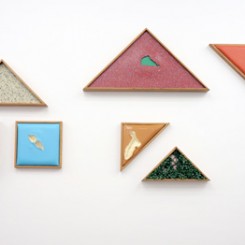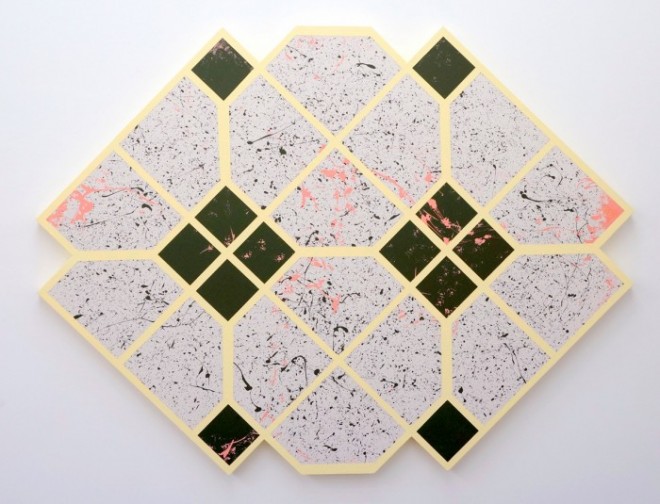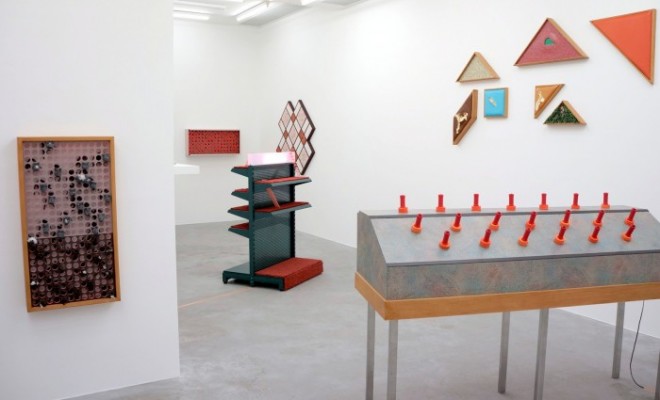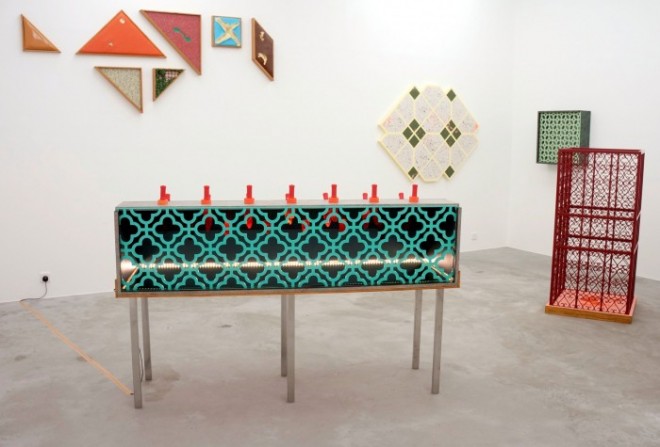Rodentia in Absentia
Saamlung (26B Two Chinachem Plaza, 68 Connaught Rd., Central, Hong Kong) Nov 23- Dec 29, 2012
“Rodentia in Absentia” is the quirky title of Adrian Wong’s current solo exhibition. That the artist has put a great deal of effort into conceiving and realising these works does not go unnoticed. Saamlung’s compact white space plays host to a mini-landscape of planar sculptural pieces or objects — one draws a sensation of containment and territory from grids, shelving and frames. Flat colour resonates with an air of ordinariness or urban standardisation (institutional reds and greens), and works mounted on the wall have tessellated or endlessly replicable outlines as if cut from a greater pattern (this idea evokes all the more in the context of Hong Kong’s socio-urban tapestry). There is also something slightly sci-fi or filmic in these re-constituted appearances — the feel of selection, subtraction and representation that pervades much of Wong’s work as he perceives and processes his Hong Kong environment, and often through the lens of TV or film.
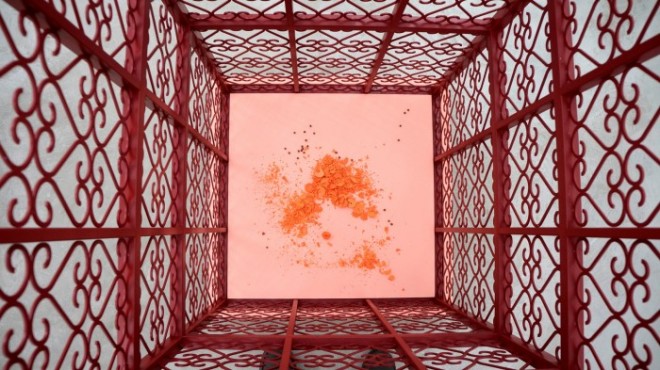
Adrian Wong, “Solitary Confinement” (detail), 2012, Steel, body paint, latex, plywood, and stain, 144 x 73 x 73 cm
Whilst the fabric of these works has been created by the artist with acute care, there is a performative aspect to their execution which he merely oversaw, and to which the title of the show relates. Filling in the white space between the grid lines in the latex and plywood piece “Two to the East, One to the West” (2012) is a film of thin splinters and trails of pink paint. These were created not by the hand of the artist, but by the feet of rats scuttling over the surface — indeed, on closer inspection one can see paw prints in the dark green diamond shapes in the middle (the note of cuteness one sometimes finds in Wong’s work might this time be found here, and also in the toy rats poking through holes in “As Above, So Below,” 2012). Elsewhere in the exhibition, one discovers, rodents participated in other ways. The wall boxes (“The Irrevocable Sadness of Colette’s Thank You,” 2012, for example) contained hamsters and rats that lived in them for a time and whose tooth marks are visible on the grates; a grouping of triangular works in different sizes upholstered with laminate vinyl and foam (“A Hare Turned Two-Hundred and Seventy Degrees,” 2012) have been chewed through in places where the animals smelt food hidden underneath.
Thus does the exhibition — strictly conceptual at the outset — reveal the activities that contributed to its creation. In the manner of Wong’s previous work, these pieces have come about at the intersection of sculptural form, research methods (looking at animal behaviour), performance and Hong Kong’s specific urban environment, its street furniture and sensations. The atmosphere is infused with a sense of the artist’s affection for form and for life (the rats are named and thanked in the exhibition text), and for the viewer, perhaps, the visual satisfaction of aesthetic objects cast from the familiar. “Rodentia in Absentia” comes across as one of the more intensely sculptural of Wong’s projects, where filmic references (the artist’s statement recalls Alejandro Jodorowsky’s film “The Holy Mountain,” where animals enact human action) and performance have been poured into the process of the works, rather than their final display.
Underpinning this project, however, is a temporal focus. Wong’s practice is associated with the idea of a rolling present — a continuum of culture and reference that simply “is” and at the same time unfolds seemingly without the bindings of history or the promise of future. Apparently, and due to the operations of instinct (this we may glean from the exhibition text), ”the mental operations of non-primates approximate a twilight of perpetual present.” Thus, featuring sculptural objects marked by the actions of these moment-bound, recollection-less rodents might offer the possibility of an conventional narrative kept in the now — in the words of the text: “storytelling in a perpetual present.” In these terms, one might interpret the project and its ultimate exhibition as a unity of presence and the present — as if the former (a specific kind of presence based on the instinctive existence of the rodents), made concrete and recast as aesthetic, can sustain a perpetual state of the latter.
“Rodentia in Absentia” is therefore an engaging and memorable show on different levels — for the aesthetic quality of these well-executed and balanced sculptural objects, for the sustained engagement it represents by the artist with his chosen fields of interest and research, and finally the tidy fusion of the two under the auspices of exploring narrative and time, and the chance of something different therein. The exhibition is at once compelling and charming as a reflection of Wong’s very persona artistic methods. That he has no qualms about rodents — amongst the lowliest of urban inhabitants — contributing actively to his refined art works (which in turn are emblematic of the city) is both pleasantly amusing and somehow appropriate.
